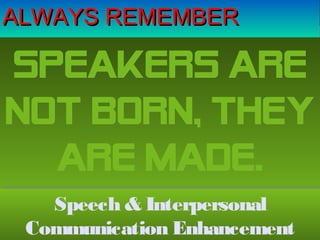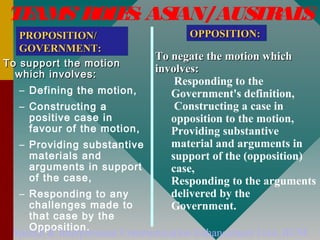Debate guide
- 1. AAAALLLLWWWWAAAAYYYYSSSS RRRREEEEMMMMEEEEMMMMBBBBEEEERRRR SSppeeaakkeerrss aarree nnoott bboorrnn,, tthheeyy aarree mmaaddee.. Speech & Interpersonal Communication Enhancement Unit, IIUM
- 2. BENEFITS OF DEBATING âĒ Cultivates qquuiicckk aanndd mmuullttii-- ddiimmeennssiioonnaall,, llooggiiccaall tthhiinnkkiinngg.. âĒ EEnnhhaanncceess tthhee aabbiilliittyy ttoo ddeevveelloopp rreeaassoonneedd ooppiinniioonnss.. âĒ GGiivveess aa bbeetttteerr uunnddeerrssttaannddiinngg ooff tthhee ccuurrrreenntt eevveennttss aanndd tthhee wwoorrlldd aarroouunndd uuss.. âĒ IImmpprroovveess sseellff--ccoonnffiiddeennccee,, ssppeeaakkiinngg ssttyyllee aanndd ccoommmmaanndd ooff llaanngguuaaggee.. âĒ EEnnrriicchheess yyoouurr oovveerraallll lleeaaddeerrsshhiipp qquuaalliittiieess.. Speech & Interpersonal Communication Enhancement Unit, IIUM
- 3. GOOD DEBATERS POSSESS âĒ Good knowledge ooff ccuurrrreenntt iissssuueess.. âĒ AAbbiilliittyy ttoo ggeenneerraattee iiddeeaass.. âĒ AAbbiilliittyy ttoo tthhiinnkk ccrriittiiccaallllyy aanndd llooggiiccaallllyy.. âĒ AAbbiilliittyy ttoo pprreesseenntt tthhee iiddeeaass ssyysstteemmaattiiccaallllyy.. âĒ AAbbiilliittyy ttoo hhaannddllee ccuullttuurraallllyy ddiivveerrssee aanndd cchhaalllleennggiinngg ssiittuuaattiioonnss wwiitthh ggrreeaatt eeaassee aanndd ttoo oonneeââss tthheeiirr ((oowwnn)) eennjjooyymmeenntt.. Speech & Interpersonal Communication Enhancement Unit, IIUM
- 4. DIFFERENT FORMATS OF DEBATES âĒ PPaarrlliiaammeennttaarryy && NNoonn--ppaarrlliiaammeennttaarryy â Parliamentary debates allow Points of Information (POI) while Non-Parliamentary debates do not. âĒ MMaallaayyssiiaann CCoonnvveennttiioonnaall â 3 members to a team â Topics given in advance â POIs not allowed âĒ AAmmeerriiccaann PPaarrlliiaammeennttaarryy â 2 members to a team â POIs are allowed Speech & Interpersonal Communication Enhancement Unit, IIUM
- 5. DIFFERENT FORMATS OF DEBATES âĒ RRooyyaall MMaallaayyssiiaann// AAssiiaann â 3 members to a team â POIS are allowed. âĒ BBrriittiisshh PPaarrlliiaammeennttaarryy ((WWoorrlldd DDeebbaatteess)) â 2 member to team and 4 teams in a debate â POIs are allowed Opening Gov. Closing Opp. Opening Opp. Speaker/ Chairperson Audience Set up in a British Parliamentary Format of Debate Closing Gov. Speech & Interpersonal Communication Enhancement Unit, IIUM
- 6. A DEBATE IS JUDGED ON THE BASIS OF: 1. Matter: What you present (i.e. the content) 2. Manner: How you present (i.e. the style) 3. Method: Organisation/ structure of your presentation Speech & Interpersonal Communication Enhancement Unit, IIUM
- 7. ELEMENTS OF MATTER 1. Definitions: 4. Rebuttals: - Set up of the debate 2. Arguments: - Must be logical - Must be relevant 3. Evidences: - Must be logical - Must be relevant - Must be prompt - Must be relevant - Evidential value (strength) Speech & Interpersonal Communication Enhancement Unit, IIUM
- 8. DEFINING A TOPIC âĒ Explain the kkeeyy--wwoorrddss iinn tthhee ttooppiicc.. âĒ IIddeennttiiffyy wwhhaatt yyoouu wwaanntt ttoo pprroovvee aanndd wwhhaatt iiss yyoouurr ssttaanndd.. TThhiiss iiss ccaalllleedd tthhee tthheemmee ooff yyoouurr tteeaamm.. âĒ IIff tthheerree iiss aa mmeeaassuurreemmeenntt iinnvvoollvveedd,, sseett uupp tthhee yyaarrddssttiicckk oorr ccrriitteerriiaa ffoorr ssuucchh mmeeaassuurreemmeenntt.. Speech & Interpersonal Communication Enhancement Unit, IIUM
- 9. RULES OF DEFINITION Characteristics of a Proper Definition: âĒ It must bear a close relation to the motion. âĒ It must not be truistic. âĒ It must not employ time or place setting. âĒ It must not be based on overly specific knowledge Kinds of Definitions: âĒ Literal with key-words definition. âĒ Metaphorical definition. âĒ Issue based &/or specified definition (different from time-place setting). Speech & Interpersonal Communication Enhancement Unit, IIUM
- 10. CHALLENGE OF DEFINITION Grounds for Challenge: âĒ You can only challenge a definition if it violates any of the criteria stated earlier. Frequently used terms in challenging definitions are: wholly unreasonable, squirrel, time-place set, truistic. âĒ You cannot challenge a definition simply because you have a more reasonable or better definition. Speech & Interpersonal Communication Enhancement Unit, IIUM
- 11. CHALLENGE OF DEFINITION âĒ Challenge must come from the leader of the opposition, not later. âĒ Leader of the opposition must provide an alternative definition. âĒ In most of the cases, the teams must introduce an 'even ifâ argument. âĒ An `Even if' argument is not possible in some cases. (e.g. truistic definition & definition running counter to the resolution i.e. where govt. has taken the oppositionâs case). âĒ In a definition debate, all the speakers except the PM argue the following: âĒ Why challenge? âĒ Validity/ invalidity of the two definitions. âĒ Even if we are to accept the other side's definition, these are the weaknesses of their case. âĒ Positive case under their own definition. Speech & Interpersonal Communication Enhancement Unit, IIUM
- 12. GETTING THE RIGHT ARGUMENTS âĒ First, identify what you have to prove under the topic. âĒ Then, identify what helps you to prove it. Put them in the format of an argument or a set of arguments. âĒ Not everything that you know on the subject is relevant. âĒ Anticipate the questions that may be raised against your arguments and see if you have good answers to them. âĒ Block the opportunity for those questions to be raised by addressing them briefly as you explain the argument. âĒ Present the arguments in order of their strength. âĒ Avoid empty rhetoric and emotionalism - be rational. Speech & Interpersonal Communication Enhancement Unit, IIUM
- 13. ESTABLISHING AN ARGUMENT Basic statement Logical explanations of why and how the basic statement stands Proofs/ evidences/ examples that factually establish your basic statement Conclusion/ how it proves your teamâs theme Speech & Interpersonal Communication Enhancement Unit, IIUM
- 14. EFFECTIVE REBUTTALS A t t a c k s R e b u t t a l s ( R e b u t t h e A r g u m e n t s ) D e f e n c e ( R e b u t t h e R e b u t t a l s ) âĒ Do not rebut the example, attack the very premise of the argument of the other side. Only then contrary examples can be supplemented. âĒ It is advisable to provide multiple rebuttals to each argument of the other side. âĒ Rebuttals should also be in conformity with your case. âĒ Rebut the rebuttals of your case by the other side in order to defend your case. Speech & Interpersonal Communication Enhancement Unit, IIUM
- 15. ELEMENTS OF MANNER/STYLE âĒ Respectable attitude towards the judges and the other team. âĒ Vocal style: volume, clarity, pace, intonation etc. âĒ Use of notes: not to read a written text. âĒ Eye contact. âĒ Body language: hand gestures, pacing, standing etc. âĒ Impression of sincerity. âĒ Humour, wit, appropriate and healthy sarcasm. Speech & Interpersonal Communication Enhancement Unit, IIUM
- 16. ELEMENTS OF METHOD - TTeeaamm ssttrruuccttuurree - Continuity of teamâs theme in all the speeches. - Consistency among all the speakers (no contradictions) - Reinforcement of team members' arguments - Clear & logical separation between arguments. - IInnddiivviidduuaall SSttrruuccttuurree - Attractive opening/ outline of the speech. - Proper organisation & priority of the arguments. - Organisation of rebuttals. - Appropriate timing of the speech - Summary of the speech. - RReessppoonnsseess ttoo tthhee ddyynnaammiiccss ooff tthhee ddeebbaattee - Right thing at the right time. - Ability to follow the progression of and changes in the Spedeechb a&te I,n taenrpde rtsoo nreal- aCcotm amccuonircdaitniognly E. nhancement Unit, IIUM
- 17. MODEL INDIVIDUAL SPEECH Definitions/ theme of the team Rebuttals (attacks and defence) Reiteration and defence of your own teamâs case Presentation of your own arguments Conclusion (why your teamâs case stands and other teamâs case does not) Speech & Interpersonal Communication Enhancement Unit, IIUM
- 18. TEAMSâ ROLES: ASIAN/ AUSTRALS PPRROOPPOOSSIITTIIOONN// GGOOVVEERRNNMMEENNTT:: TToo ssuuppppoorrtt tthhee mmoottiioonn wwhhiicchh iinnvvoollvveess:: â Defining the motion, â Constructing a positive case in favour of the motion, â Providing substantive materials and arguments in support of the case, â Responding to any challenges made to that case by the Opposition. OOPPPPOOSSIITTIIOONN:: TToo nneeggaattee tthhee mmoottiioonn wwhhiicchh iinnvvoollvveess:: Responding to the Government's definition, Constructing a case in opposition to the motion, Providing substantive material and arguments in support of the (opposition) case, Responding to the arguments delivered by the Government. Speech & Interpersonal Communication Enhancement Unit, IIUM
- 19. TEAM ROLES: BRITISH PARLIAMENTARY - Defines - Builds a positive case to support the motion - Responds to the Opp.âs case. OPENING OPP. - Responds to the governmentâs case - Builds a case to oppose the motion - Supports the Opening Gov.âs case, - Adds new dimensions, arguments to further substantiate the governmentâs case. - Responds to the Opp.âs case - Supports the Opening Opp.âs case - Adds new dimension, arguments in Opp.âs case - Responds to governmentâs case OPENING GOV. CLOSING GOV. CLOSING OPP. Speech & Interpersonal Communication Enhancement Unit, IIUM
- 20. SPEAKERS' ROLES: ASIAN/ AUSTRALS âĒ 1st SSppeeaakkeerr //PPrriimmee MMiinniisstteerr PPRROOPPOOSSIITTIIOONN// GGOOVVEERRNNMMEENNTT:: â Defines the topic. â Gives the case structure and theme. â Presents own arguments. â Provides a summary of his speech. (What I've given u so far..). âĒ 22nndd SSppeeaakkeerr â Rebuts. â Reiterates and defends his first speakerâs arguments. â Presents own argument. â Provides a summary of his speech. âĒ 33rrdd SSppeeaakkeerr â Rebuts substantially. â Reiterates and defends his own team's case. â Provides a summary of his speech. âĒ RReeppllyy SSppeeaakkeerr â PPrreesseennttss aa ccoommppaarraattiivvee oovveerrvviieeww ooff tthhee ccllaasshh ppooiinnttss iinn tthhee ddeebbaattee pprroovviinngg wwhhyy hhiiss tteeaammââss ccaassee ssttaannddss Speech & Interpersonal Communication Enhancement Unit, IIUM
- 21. SPEAKERS' ROLES: ASIAN/ AUSTRALS OOPPPPOOSSIITTIIOONN:: âĒ 1st Speaker //OOppppoossiittiioonn LLeeaaddeerr â RReessppoonnddss ttoo tthhee ddeeffiinniittiioonn ((ii..ee.. AAcccceeppttss,, RReejjeeccttss oorr CCllaarriiffiieess)).. â RReebbuuttss tthhee PPrriimmee MMiinniisstteerrââss aarrgguummeennttss.. â GGiivveess tthhee ccaassee ssttrruuccttuurree aanndd tthheemmee ooff hhiiss tteeaamm.. â PPrreesseennttss oowwnn aarrgguummeennttss.. â PPrroovviiddeess aa ssuummmmaarryy ooff hhiiss ssppeeeecchh.. âĒ 22nndd SSppeeaakkeerr â SSaammee aass tthhee pprrooppoossiittiioonn 22nndd ssppeeaakkeerr âĒ 33rrdd SSppeeaakkeerr â SSaammee aass tthhee pprrooppoossiittiioonn 33rrdd ssppeeaakkeerr âĒ RReeppllyy SSppeeaakkeerr â SSaammee aass tthhee pprrooppoossiittiioonn rreeppllyy ssppeeaakkeerr Speech & Interpersonal Communication Enhancement Unit, IIUM
- 22. POINTS OF INFORMATION (POIs) âĒ A POI can be in a question oorr ssttaatteemmeenntt ffoorrmm aanndd sshhoouulldd nnoott ttaakkee mmoorree tthhaann 1155 sseeccoonnddss.. âĒ EEaacchh ssppeeaakkeerr sshhoouulldd aacccceepptt aatt lleeaasstt ttwwoo PPOOIIss.. âĒ AAllll tthhrreeee mmeemmbbeerrss ooff tthhee tteeaamm sshhoouulldd ttrryy ttoo ggiivvee PPOOIIss,, bbuutt tthheeyy mmuusstt nnoott bbee ddiissrruuppttiivvee.. âĒ PPOOIIss aarree jjuuddggeedd oonn tthhee bbaassiiss ooff:: - tthhee tthhrreeaatt tthheeyy ppoossee ttoo tthhee ssttrreennggtthh ooff tthhee aarrgguummeenntt ooff tthhee ddeebbaatteerr.. - vvaalluuee ooff iittss wwiitt aanndd hhuummoouurr.. âĒ RReessppoonnsseess ttoo tthhee PPOOIIss aarree jjuuddggeedd oonn tthhee bbaassiiss ooff:: â pprroommppttnneessss aanndd ccoonnffiiddeennccee iinn aannsswweerriinngg.. â ssttrreennggtthh ooff tthhee rreessppoonnssee.. â vvaalluuee ooff wwiitt aanndd hhuummoouurr iinn tthhee rreessppoonnssee.. Speech & Interpersonal Communication Enhancement Unit, IIUM





















